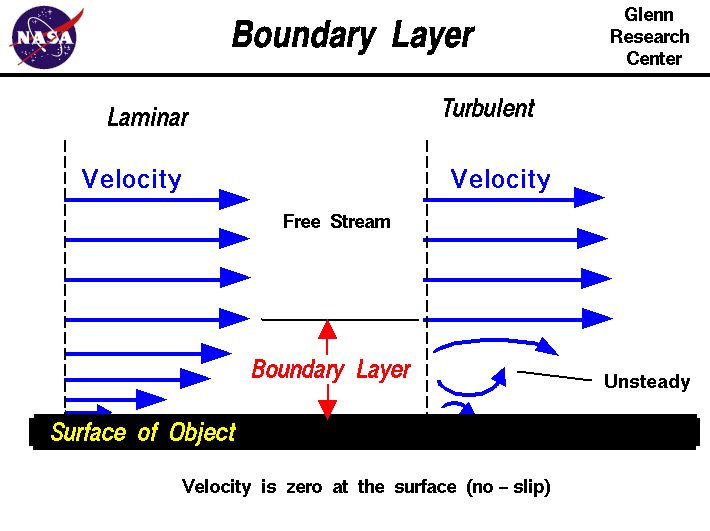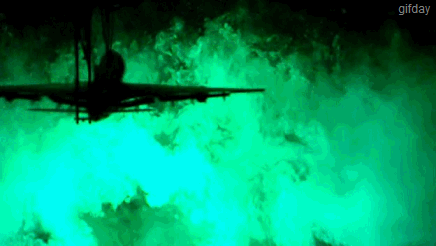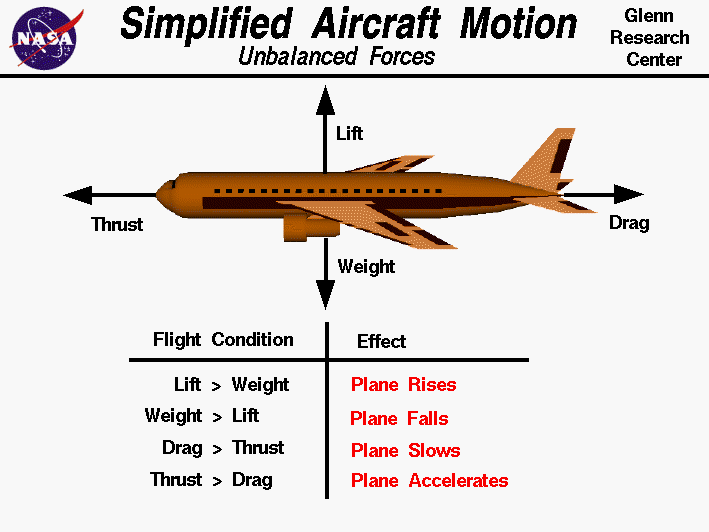
Take-off
Take-off
Introduction to aircraft
Introduction to aircraft
Introduction to aircraft
Introduction to aircraft
Introduction to aircraft
How do airplanes fly ?

Airplanes fly thanks to simple principles of physics and aerodynamics, which we will explain in this section.

Assuming an airplane, which is cruising, so it has a constant speed in a galilean reference frame.
We can say by the fundamental principle of dynamics that : F ext = m.a .
In english in means that all forces applied on the airplane are equal to its mass times its acceleration, but it has a constant speed so its acceleration is 0. F ext = 0 .
We find the first law of Newton : If a body is moving at a constant speed in one
direction or is at rest, he will keep its stats unless it is acted upon by a force.
If we write all the forces applied to our plane we can find the relation :
F thrust + F lift + F drag + F gravity = 0.
We can see that the thrust and the drag are in the same direction. Let’s begin gently by saying that they balance each other. F thrust = - F drag.
We clearly see that the force of lift and force of gravity have to balance each other as well, so the plane can stay in the air.


So what is lift ? How is it created ?
One of the explanation for lift is based on the bernoulli equation :
P + ½ ro v ² + m g h = cst
So as we can see on the illustration of an Airfoil 4412 from the NACA on Ansys Fluent that the velocity on the top of the airfoil is higher than under the airfoil. So if the velocity v is bigger, it means that the pressure P is less importante. Under the airfoil we have the same phenomena but with less velocity so higher pressure.

If we take at the same time what happens over and under the wing of a plane, those two phenomena generate a force known as lift. Wings and flaps can be slightly turned by the pilot to help reduce or increase the lift.

To generate the speed needed for take-off and to maintain this speed in cruise, aircraft need engines. Aircraft engines have different designs, the majority of which are the jet and propeller engine families.

Propeller engine
The easiest engine to understand is the propeller, to cut a long story short: it is a car engine. You have V o W shaped pistons that rotate a crankshaft after internal combustion. This rotation is transmitted to the blades, each of which has an aerodynamic profile. This rotation applied to the propeller plus the aerodynamic profile makes the aircraft accelerate. It is the same principle as we have seen before: the propeller generates lift which pulls the aircraft.

Here we have an illustration of a cross section of an internal combustion engine.
This is an illustration gif, each engine has its own characteristics and design. The engines are generally different between a car and an aeroplane but work on the same principle.


Jet engine
The second engine is the famous jet engine. Jet engines have a really different design, we have combustion as well, but it’s not an internal combustion as before. Firstly we have the compressor, there are rings used to compress the air between 10 and 40 times. Internal or external combustions have the same combustion, you need oxygen and a fuel plus an igniter. Here in jet engines, as you can see on the illustration nearby, the combustion is done in an open space. The fuel in the form of very fine droplets is mixed with the compressed air, the mixture must be as homogeneous as possible in order to achieve optimum combustion. Then the igniter puts a small spark into this mixture, which is enough energy to ignite the combustion.

When the plane is flying, we don't need to use the igniter anymore because the speed of the incoming air pushes the exhausted gases away and if we keep feeding the mixture full, the combustion never stops. To use this combustion as an energy source in its own right, the exhaust gases from the combustion are used to turn a rotor, which in turn turns the turbine at the engine inlet. This turbine sucks in air at high speed, which not only fuels the combustion but also helps to propel the aircraft.


In a few words, weight is a force applied to an object with mass. It is applied between its centre of mass and that of the earth (or any other massive object). This force can be written as follows: F = m g near the surface of the earth, where m is the mass of the object and g = 9.81 m/s^-2. As we can see, it is related to the mass of the object. That is why we try to make the aircraft as light as possible by using fibreglass, carbon or aluminium, which are strong and light materials.

In summary, we have seen how lift was created, how thrust was created and how weight was created. Last but not least, we need to understand what drag is. Drag is a force that opposes the relative motion of the aircraft, i.e. it tries to slow it down. Drag can be divided into two categories. A distinction is made between parasitic drag and induced drag.

Parasite drag

Form drag
Form drag is the most known king of drag, it’s directly related to the shape of the object we are working with. This type of drag is caused by the speed and smoothness with which two air streams come together after being separated.
Interference drag
Interference drag is a powerful drag. It is created where we have an intersection of surfaces. For instance the intersection of wings and fuselage. The drag from the wing is colliding with the one from the fuselage. Interference drag is greatest when two surfaces meet at a perpendicular angle. This can be seen in the illustration here.

Skin friction
Skin friction is the last parasite drag, it’s the aerodynamics resistance created by the moving air on the surface of the plane. We can see on the illustration that near the surface of the object / plane, the molecule velocity of air is close to 0. But each layer is faster than the previous one, it’s the same process for every layer until we reach the free stream. That means that the layer is moving the same speed as the air surrounding the airplane.


Induced drag
As we have seen before, lift is created by pressure differences above and below the wing. This is a system that works perfectly in 2D, because the high and low pressure areas are not directly connected. But in 3D we have to keep in mind that the wings have a tip. So the high and low pressure areas tried to connect together. The result is a vortex generated from the bottom to the top of the wing at the tip.
We use winglets in order to reduce that induced drag.

.png)


To conclude, we can summarise this section by saying that for an aircraft to fly it is necessary that each force applied to it compensates for the other. Thus, lift must compensate for weight and thrust must compensate for drag. This is the only way the plane can have a constant speed and altitude.
By changing the relationship between these forces we can change the trajectory of the aircraft.
